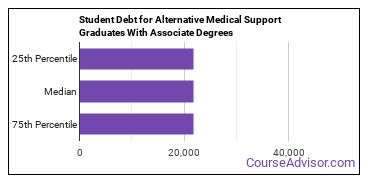Associate Degrees in Alternative Medical Support Services
Featured schools near , edit
Education Levels of Alternative Medical Support Majors
During the 2020-2021 academic year, 18 students earned their associate degree in alternative medical support. This earns it the #243 spot on the list of the most popular associate degree programs in the nation.
The following table shows the number of diplomas awarded in alternative medical support at each degree level.
| Education Level | Number of Grads |
|---|---|
| Basic Certificate | 72 |
| Master’s Degree | 68 |
| Undergraduate Certificate | 31 |
| Bachelor’s Degree | 26 |
| Associate Degree | 18 |
| Graduate Certificate | 12 |
Earnings of Alternative Medical Support Majors With Associate Degrees
We are unable to calculate the median earnings for alternative medical support majors with their associate degree due to lack of data.
Student Debt
The median student debt for graduates holding an associate degree in alternative medical support is $21,832. The school you go to and how long it takes you to graduate, among other things, can cause this number to vary. The chart below shows the range of accumulated debt loads. On the high side of the range, $21,832 is the debt load, and the debt load on the low side is $21,832.

Student Diversity
More women than men pursue their associate degree in alternative medical support. About 100.0% of graduates with this degree are female.
| Gender | Number of Grads |
|---|---|
| Men | 0 |
| Women | 18 |

The racial-ethnic distribution of alternative medical support associate degree students is as follows:
| Race/Ethnicity | Number of Grads |
|---|---|
| Asian | 0 |
| Black or African American | 1 |
| Hispanic or Latino | 3 |
| White | 12 |
| International Students | 0 |
| Other Races/Ethnicities | 2 |

Most Popular Alternative Medical Support Programs for Associate Degrees
There are 3 colleges that offer an associate degree in alternative medical support. Learn more about the most popular 3 below:
The most popular school in the United States for alternative medical support students seekingan associate degree is Midwives College of Utah. The average in-state tuition for full-time undergraduates is $7,260 per year, while in-state graduate students, on average, pay $7,260 per year. During the 2020-2021 academic year, 9 people received their associate degree in alternative medical support from Midwives College of Utah. Around 33% of these students were from an underrepresented racial-ethnic group, and 100% were women.
The 2nd most popular school in the country for alternative medical support majors who are seeking their associate degree is Southwest Wisconsin Technical College. The alternative medical support program at Southwest Wisconsin Technical College awarded 8 associate degrees during the 2020-2021 school year. Around 38% of these students were from an underrepresented racial-ethnic group, and 100% were women.
The 3rd most popular school in the country for alternative medical support majors who are seeking their associate degree is Mount Wachusett Community College. For the 2020-2021 academic year, 1 associate degrees were handed out to alternative medical support majors at MWCC.
Explore Major by State
Alabama
Arkansas
Connecticut
Florida
Idaho
Iowa
Louisiana
Massachusetts
Mississippi
Nebraska
New Jersey
North Carolina
Oklahoma
Rhode Island
Tennessee
Vermont
West Virginia
Related Majors
Below are some popular majors that are similar to alternative medical support that offer associate degrees.
| Major | Annual Degrees Awarded |
|---|---|
| Nursing | 85,504 |
| Allied Health Professions | 27,677 |
| Allied Health Services | 20,673 |
| Health/Medical Admin Services | 16,893 |
| Health Sciences & Services | 10,218 |
References
*The racial-ethnic minority student count is calculated by taking the total number of students and subtracting white students, international students, and students whose race/ethnicity was unknown. This number is then divided by the total number of students at the school to obtain the percentage of racial-ethnic minorities.
More about our data sources and methodologies.
Featured Schools
 Request Info
Request Info
|
Southern New Hampshire University You have goals. Southern New Hampshire University can help you get there. Whether you need a bachelor's degree to get into a career or want a master's degree to move up in your current career, SNHU has an online program for you. Find your degree from over 200 online programs. Learn More > |


